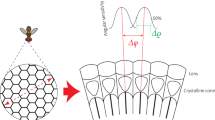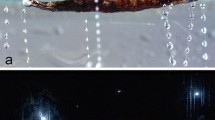Summary
Previous researches have shown that various arthropods are sensitive to ultra-violet and that the efficiency of this light is fairly high compared to that of so-called visible light. Especially has this been found to be true for the honeybee. The purpose of the present investigation was to test this matter in detail for another insect, the fruit fly Drosophila.
In order to ascertain the relative efficiency of different regions of the spectrum in calling forth responses in Drosophila, groups of flies were released a short distance from two illuminated areas placed side by side, one illuminated by white light of known intensity, the other by a narrow band of spectral light of known wave length from a monochromator. A count of the number of flies going to each area indicated which area had for them the greater brilliance. The intensity of the white light was varied from an intensity low enough (whenever possible) to attract less than half the flies used in the test, to an intensity high enough to attract more than half, and then by graphic interpolation the intensity which would theoretically attract exactly half the flies could be ascertained. This was done for about 30 different wave lengths in the spectrum, from 230 mμ up to 700 mμ. This constituted a measure of the relative effect of the different wave lengths, without regard to their relative energy. In order to get the efficiency of each spectral zone used, its energy was measured and divided into the value for relative effect.
The results show that, starting with the longer wave lengths, the efficiency is very low until it starts to rise at about 575 mμ; from here it rises to a maximum in the so-called visible spectrum at 487 mμ where it is given an arbitrary value of 100; from this wave length it decreases again to 22 at 425 mμ; then it rises suddenly and attains a maximum value of 561 at 365 mμ; from here it decreases rapidly to a value of 24 at 280 mμ, then rises slightly to 51 at 254 mμ and from there decreases rapidly to zero at about 230 mμ. The lowest wave length at which any definite stimulation could be observed was 235 mμ, the highest 650 mμ.
Various considerations point to the conclusion that although the parts of the eye may fluoresce under ultra-violet illumination, this cannot account entirely for the very great efficiency of ultra-violet in stimulating Drosophila.
Similar content being viewed by others
Literature cited
Bertholf, L. M.: Reactions of the honeybee to light. J. agricult. Res. Wash. 42, 379–419 (1931 a).
—: The distribution of stimulative efficiency in the ultraviolet spectrum for the honeybee. Ebenda 43, 703–713 (1931 b).
Becher, S.: Die Sinnesempfindlichkeit für extremes Ultraviolett bei Daphnien. Verh. dtsch. zool. Ges. 28, 52–55 (1923).
Crozier, W. J.: Wave length of light and photic inhibition of stereotropism in Tenebrio larvae. J. gen. Physiol. 6, 647–652 (1924).
Gross, A. O.: The reactions of arthropods to monochromatic lights of equal intensities. J. of exper. Zool. 14, 467–514 (1913).
Hecht, S.: The relation of time, intensity and wave-length in the photosensory system of Pholas. J. gen. Physiol. 11, 657 to 672 (1928).
von Heß, C.: Die Grenzen der Sichtbarkeit des Spektrums in der Tierreihe. Naturwiss. 8, 197–200 (1920 a).
—: Die Bedeutung des Ultraviolett für die Lichtreaktionen bei Gliederfüßlern. Arch. ges. Physiol. 185, 281–310 (1920 b).
Kühn, A. a. Pohl, R.: Dressurfähigkeit der Biene auf Spektrallinien. Naturwiss. 9, 738–740 (1921).
Lubbock, J.: Ants, Bees, and Wasps. London 1881.
Lutz, F. E.: Apparently non-selective characters and combinations of characters, including a study of ultraviolet in relation to the flower-visiting habits of insects. Ann. New York Acad. Sci. 29, 181–283 (1924).
Lutz, F. E. a. Richtmyer, F. K.: The reaction of Drosophila to ultraviolet. Science (N. Y.) 55, 519 (1922).
Mast, S. O.: The relation between spectral color and stimulation in the lower organisms. J. of exper. Zool. 22, 471–528 (1917).
Merker, E.: Die Fluoreszenz im Insektenauge, die Fluoreszenz des Chitins der Insekten und seine Durchlässigkeit für ultraviolettes Licht. Zool. Jb., Abt. Allg. Zool. u. Physiol. 46, 483 bis 574 (1929).
—: Sehen die Daphnien ultraviolettes Licht? Ebenda 48, 277–348 (1930).
Schlieper, C.: Über die Helligkeitsverteilung im Spektrum bei verschiedenen Insekten. Z. vergl. Physiol. 8, 281–288 (1928).
Visscher, J. P. a. Luce, R. H.: The reaction of cyprid larvae of barnacles to light with special reference to spectral colors. Biol. Bull. Mar. biol. Labor. Wood's Hole 54, 336–350 (1928).
Author information
Authors and Affiliations
Additional information
National Research Fellow in the Biological Sciences, National Research Council, U. S. A. The writer is especially indebted to Professor K. von Frisch, Zoological Institute, University of Munich, for placing at his disposal the facilities with which to carry out this investigation and for giving him much kindly advice, as well as extending to him a host of courtesies while a guest at this Institute.
Rights and permissions
About this article
Cite this article
Bertholf, L.M. The extent of the spectrum for Drosophila and the distribution of stimulative efficiency in it. Z. f. vergl. Physiologie 18, 32–64 (1932). https://doi.org/10.1007/BF00338152
Received:
Issue Date:
DOI: https://doi.org/10.1007/BF00338152




